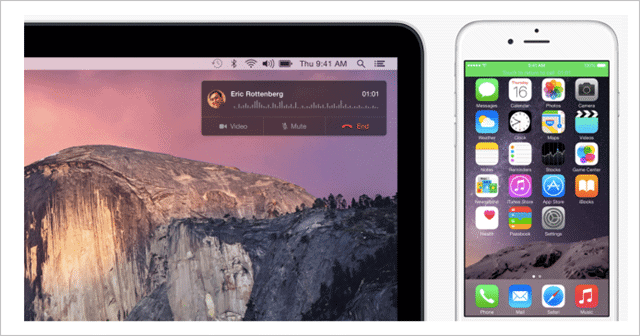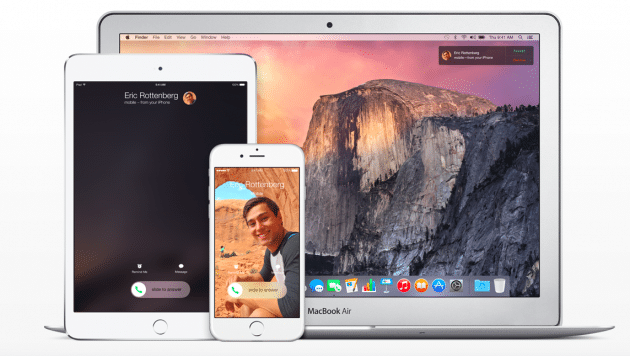Making Calls on Mac OS
Desktop users have made phone calls from their computers since the introduction of VoIP services. However the latest upgrade to Mac and iOS has transformed communication methods that could revolutionize the industry in the coming years. Apple introduced the highly anticipated Continuity and Handoff features that allow users to control their handheld devices from their Mac.
This allows users to make and receive calls on their Mac exactly like they do on their handheld devices. Handoff allows users to transfer calls from their Mac to any other Apple device and vice versa.
Users can now pick up their call on one device and transfer it without disconnecting to another device, be it a computer or a handheld device. Let’s explore how it works and then dive into ways you can make phone calls from your Mac in Yosemite.
Also See: Everything You Wanted to Know About Apple Pay and How to Use It
What is Continuity and How Does Handoff Help?

Continuity is the latest addition to Apple’s OS upgrades. The feature is available to users who can upgrade their previous Mac operating systems to Yosemite and iOS to iOS 8.
Apple has developed Continuity as an extension to FaceTime Audio to allow connected calls to be transferred among devices. This allows easy transfer and control of your handheld Apple devices from your Mac. This feature perfectly describes Apple’s vision of interconnected devices. Continuity comprises of 5 sub features namely:
- Handoff: Handoff allows device interconnectivity and application synchronization in paired Apple devices. Therefore, users can pick up from where they left off on another device. It allows major applications like mail, documents and other apps that are supported on their devices. The API is also open to developers allowing the feature to be embedded for any application of their choice.
- Instant Hotspot: This allows your Apple devices to share a mobile internet connection from a common hotspot. A Wi-Fi hotspot can be instantly created and shared between devices present nearby without any additional setup processes, software’s or hardware.
- Phone Calls: Unlike previous Apple desktop OS’s, Yosemite now allows users to make, receive and control phone calls from their desktop. This phone call can be transferred among devices without disconnecting through Handoff.
- Text Messages: Like your handheld devices, you can now send SMS and MMS iMessages through your desktop or any other device that supports Continuity.
- Airdrop: This is the first of its kind cloud based file sharing application ever to be inbuilt into operating systems. Airdrop allows you to share any document between your devices regardless of its location. With just a few clicks you can access the file that you were editing on a Mac.
How to Make Phone Calls from Your Mac?
With the latest upgrades, you can easily control phone calls from any of your devices provided all the devices have the latest operating systems. Along with that the devices should be connected to the same Wi-Fi network. Your devices need to remain signed in your iCloud and FaceTime using your Apple ID and should have iPhones Cellular Calls turned on. Even though you will be calling from your desktop, the charges will be deducted from your iPhone cellular network.
You can make calls on your desktop from Facetime, Mail, Maps, Spotlight, Safari and Contacts. If you want to call from:
- Facetime: Open Facetime and select Audio to see your past phone calls or just enter a number and click Audio to make a call.
- Mail: When browsing through an email that contains a phone number, hover the pointer over it and open a pop up menu that shows a list of devices through which you can make calls. Select the device to make call.
- Safari: Whenever you make a call to a phone number listed on a webpage, hover over it and click the pop up menu to select the device to make a call.
- Maps: If you find an interesting place then hover your pointer over it and click the info button. If there is a phone number, hover over it and then click the phone button to make a call.
- Contacts: Open contacts and select any one you like. Hover your pointer over the phone number and click the phone button to start the call. If there is no phone number, edit the contact, add the phone number and then call.
- Spotlight: type in the name of the person or place that you want to call, select the matching result and click on the phone button that pops up when you move your pointer over the phone number.
Handoff can handle all of the above features and transfer them among devices that support them. If third-party applications are involved in making calls, the application installed in iOS devices should also support handoff to allow inter-device application data transfer. Each call made from the desktop can be received, merged and replied back with a text when rejected, just like it works in iOS devices.
SEE ALSO: How to Track, Wipe and Disable a Lost iPhone, iPad or Mac
What If You Can’t Upgrade?

Unfortunately, not everyone can upgrade to the least Mac and iOS release to experience the awesomeness of continuity. Therefore users can still make calls from usual VOIP services like Skype and Google Voice.
The VOIP services may not allow handoff features like Yosemite but some applications like Viber etc. can provide handoff like functionalities. There are numerous applications and services on the Apps store that can be used to replicate handoff and Continuity features in Mac systems that cannot be upgraded. Explore and find the best apps to make do with desktop calling.
SEE ALSO: 5 Pro Tips to Take Better Pictures with Your iPhone and iPad
Conclusion
With the introduction of Continuity, Apple has opened up new frontiers for OS manufacturers to focus on. Now organizations like Google and Microsoft have also started researching on merging their applications across devices allowing users to control their respective mobile devices through their desktop operating systems. Microsoft in its next release plans to unify all its Operating systems under one banner so that each device can seamless connect with each other.
Google on the other hand is striving to perfect its Chrome OS that is yet to see some consumer interest. Therefore, Apple with its latest upgrade has made a huge leap in to the future with its Continuity feature. Although some instances show some bug reports, the stable OS release would definitely see improvements in functionality, design and stability like all previous Apple Products.









